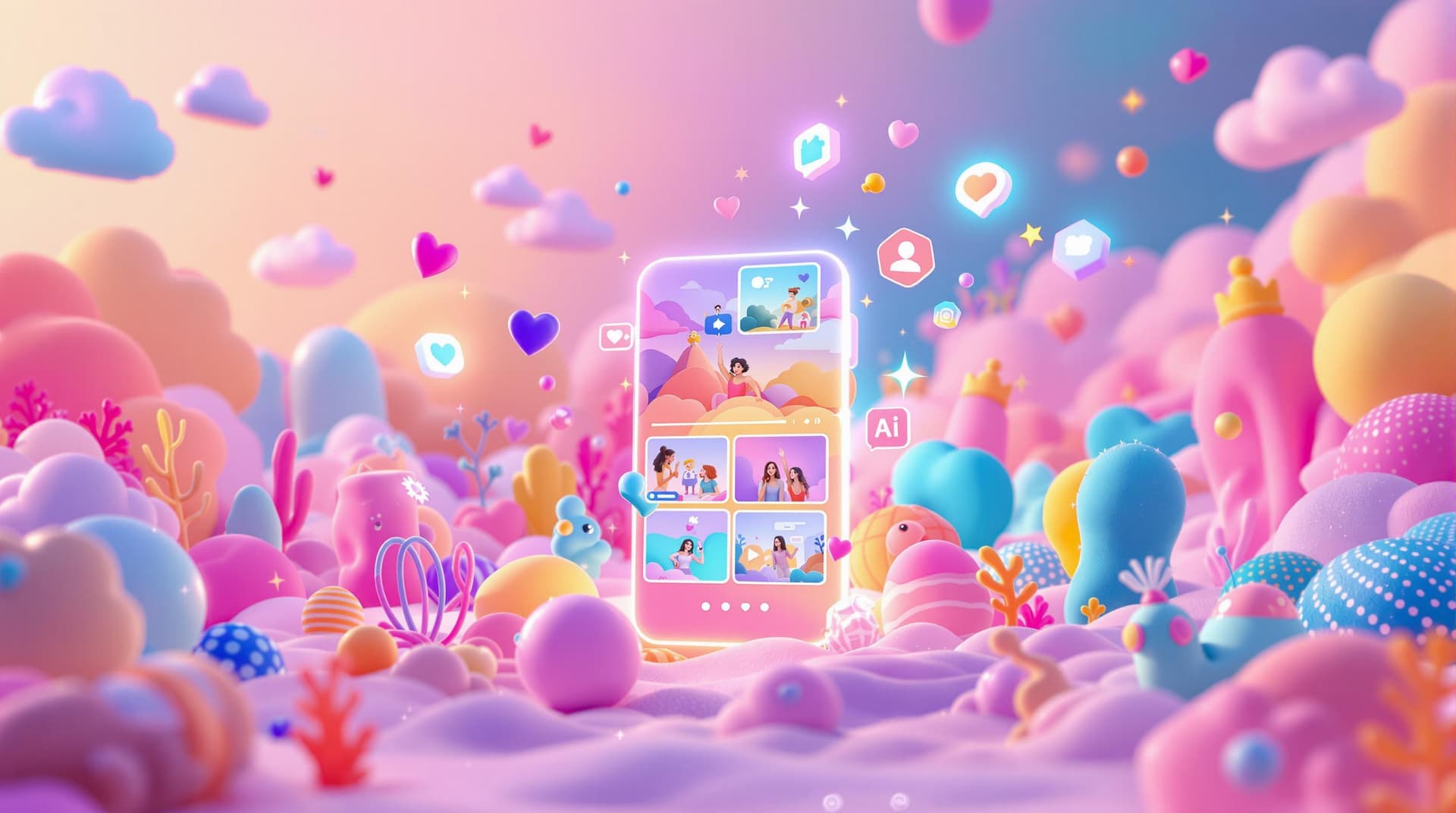
Want to save money and improve your ad performance? AI-generated user-generated content (UGC) is transforming digital marketing in 2025. Here's why it works and how you can start:
- Save Money: AI UGC cuts production costs by 50% - from $150+ per video to just $4.
- Boost Conversions: Achieve 28% higher conversion rates and 4× better click-through rates than traditional influencer ads.
- Save Time: Create content in minutes instead of days with tools like MagicUGC.
- Engage Audiences: UGC ads are trusted 2.4× more than standard ads, leading to 73% better engagement.
AI UGC simplifies ad creation, reduces costs, and drives better results. Ready to learn how it works? Keep reading for strategies, tools, and tips to get started.
How to Make Viral UGC Ads with AI in 2025
Cost Reduction Through AI UGC
AI-generated user-generated content (AI UGC) offers a much cheaper alternative to traditional methods, making it an attractive option for businesses looking to scale content production without breaking the bank.
Current UGC Production Costs
Creating traditional influencer videos can cost anywhere from $150 to $1,000 per video, with additional fees often tacked on. When you need to scale production, these costs can quickly add up.
| Cost Component | Traditional UGC | AI UGC |
|---|---|---|
| Per Video Cost | $150–$1,000 | Around $4 |
| Production Time | Several days to weeks | About 10 minutes |
| Shipping Costs | Additional fees may apply | None |
| Revision Rounds | Multiple rounds | Instant revisions |
AI Cost Savings
Platforms such as MagicUGC provide unlimited video creation for a flat monthly fee. For example, their Turbo Plan costs $249 per month, which brings the per-video cost down to roughly $4 for 60 or more videos. This model eliminates expenses like creator fees, product shipping, long production timelines, and multiple revision cycles.
By cutting these costs, businesses can stretch their budgets further and improve the overall performance of their campaigns.
Results: Lower Costs with More Content
In February 2024, Imalent slashed their per-video cost from over $150 to just $4, leading to 170.3K views (compared to 13.9K previously), four times more likes, and double the comments.
ChargeHub, an EV charging app, also saw impressive results. Their campaign using AI UGC reduced the cost per install by 46% compared to traditional banners and animations, all while maintaining strong engagement. This cost efficiency allowed them to experiment with various creative formats on platforms like Facebook and Instagram Reels, without increasing their marketing budget.
Conversion Improvements with AI UGC
AI-powered user-generated content (UGC) ads not only save costs but also deliver noticeable improvements in campaign performance. Here's how these ads outshine traditional influencer methods, supported by key metrics and advanced AI-driven strategies.
Performance Metrics
Data from Creatify (November 2023) highlights the following results:
| Metric | Performance with AI UGC |
|---|---|
| Click-through Rate | 4× higher compared to traditional ads |
| Web Conversions | 29% increase |
| Overall Campaign Performance | 25% improvement |
| Positive Comments | 73% more than traditional ads |
AI Script Performance
AI tools leverage massive amounts of social media data to craft scripts designed to resonate with specific audiences. These scripts are fine-tuned in real time, ensuring better targeting, faster adjustments, and consistent quality.
Results: AI vs. Influencer Content
The advantages of AI-generated UGC are clear when compared to influencer-created content. AI UGC delivers 8.7 times better results than influencer campaigns and is 6.6 times more effective than standard branded material. This translates to a steady 10% increase in conversion rates. On top of that, 92% of consumers say they trust UGC ads more than traditional advertising.
sbb-itb-d822133
Starting with AI UGC Marketing
Picking the Right AI UGC Tool
When it comes to AI UGC platforms, focus on tools that match your marketing goals and fit your budget. For instance, MagicUGC offers plans starting at $149 for basic features, while their $249 premium plan includes unlimited AI videos and advanced options.
Here are some key features to look for:
- Avatar Diversity: A range of AI personas representing different demographics.
- Script Generation: Tools for optimizing scripts based on data.
- Language Support: Multi-language options to reach global audiences.
- Analytics Integration: Built-in tools to track performance.
- Brand Customization: Features that ensure your brand identity stays consistent.
Once you’ve chosen the right tool, it’s time to put your strategy into action.
Steps to Get Started
Follow these three steps to implement AI UGC effectively:
-
Define Your Campaign Goals
Set clear objectives and pinpoint your target audience. This helps shape your AI UGC strategy to meet specific needs. -
Develop Your Content Strategy
Build a creative concept that aligns with your brand’s voice. Use high-quality materials, such as clear brand guidelines and messaging frameworks, to guide the AI in producing relevant content. -
Generate and Test Content
Create multiple video variations and test them. Identify which ones perform best, and refine your approach based on audience responses.
These steps will help you integrate AI UGC into your campaigns smoothly while setting the stage for ongoing success.
Measuring and Improving Campaign Performance
Tracking results is key to making the most of your AI UGC campaigns. Successful brands monitor a mix of metrics to gauge their effectiveness:
| Metric Type | Key Indicators |
|---|---|
| Engagement | Likes, shares, comments |
| Conversion | Click-through rates, sales |
| Reach | Views, impressions |
| Sentiment | User feedback, brand perception |
"Integrating AI into user-generated content (UGC) campaigns has been a game-changer. AI tools streamline content curation and offer predictive insights, suggesting what type of content will resonate best with our audience."
– Laura Mitchelson, Digital Marketing Strategist at BrightWave Solutions
To improve results, consider these strategies:
- Track performance metrics and adjust content based on real-time data.
- Use AI analytics to spot trending topics and audience preferences.
- Experiment with different AI avatars and scripts to boost engagement.
- Be transparent about using AI while keeping your messaging relatable.
With these tactics, you can fine-tune your campaigns and make them more effective.
Common Issues and Ethics
Building Viewer Trust
Trust plays a key role in the success of AI-driven UGC campaigns. Research shows that 90% of buyers value trustworthiness, with UGC being perceived as 240% more reliable than conventional advertisements. To keep trust intact when using AI-generated content, brands need to focus on being transparent and clear about their processes.
Here are some ways to build viewer trust:
| Trust Factor | Implementation Approach | Expected Outcome |
|---|---|---|
| Transparency | Content verification process | Increased credibility |
| Content Quality | Human review process | Better perception of content |
| Brand Alignment | Detailed guidelines | Consistent messaging |
| Audience Feedback | Regular monitoring | Stronger engagement |
On top of these factors, ensuring your brand voice remains steady is equally important when integrating AI-generated material.
Brand Voice in AI Content
Once trust is established, keeping your brand voice consistent in AI-generated content becomes the next priority. Advanced AI tools can analyze your existing materials to mimic your tone and style, ensuring a seamless experience for your audience.
Here’s how to maintain your brand voice effectively:
- Clearly document your tone and style guidelines.
- Upload these specifications to your AI content tools.
- Regularly monitor how the content performs across different platforms.
- Adjust AI settings based on audience feedback and engagement data.
Legal and Ethics Guide
Trust and brand consistency go hand-in-hand with legal and ethical compliance. The FTC’s 2024 guidelines emphasize the need for clear disclosure when AI is involved in content creation.
Key areas to focus on include:
1. Content Ownership Rights
According to the U.S. Copyright Office, content created entirely by AI cannot be copyrighted. However, if there’s meaningful human involvement, it may qualify for copyright protection.
2. Disclosure Requirements
Brands are required to label AI-generated videos and images clearly to avoid misleading their audience.
3. Privacy Protection
Strict measures should be in place to protect user data when AI tools are used to create content.
To stay ethical, brands should:
- Draft clear policies around UGC ownership and usage rights.
- Use moderation tools to verify facts in AI-generated content.
- Update internal guidelines to align with evolving regulations.
- Regularly review AI content to ensure accuracy and reliability.
AI is a tool to amplify human creativity, not replace it. Adhering to these principles allows brands to use AI-generated UGC effectively while maintaining trust and credibility.
Conclusion: AI UGC in Modern Marketing
AI-generated UGC is changing the game in digital advertising, offering brands a way to boost results while cutting costs. For example, brands leveraging AI UGC see 28% higher conversion rates and reduce production costs by half compared to older methods. This is thanks to AI's ability to quickly create and test multiple ad variations - no need for managing creators, shipping products, or dealing with lengthy production timelines.
From a financial perspective, traditional UGC often comes with higher costs, while AI solutions like MagicUGC offer a more budget-friendly alternative with fixed monthly fees. These tools have helped companies achieve 4× more clicks than typical influencer campaigns.
Felix Leshno, CEO of Underoutfit, sums up the value of AI UGC perfectly:
"The social media algorithm is a content-eating beast. Feed the beast and it will be good to you. Testing many creatives is the right way to reach a broad audience, more personas, and ultimately build a stronger and wider range of customers".
Research also shows that consumers find UGC 9.8× more impactful than influencer content. By blending the trustworthiness of UGC with the speed and efficiency of AI, brands can develop a scalable content strategy that performs well without losing its personal touch.
To make the most of AI UGC, marketers should focus on setting clear KPIs, using AI for quick creative testing, and ensuring a balance between automation and genuine connections. As we move further into 2025, AI-generated UGC is no longer a "nice-to-have" - it's becoming a must-have for thriving in digital marketing.



